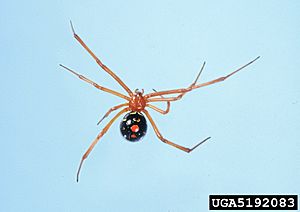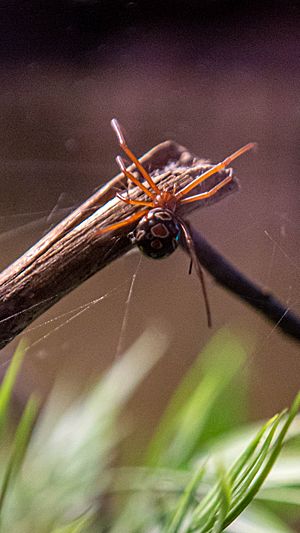Red widow spider facts for kids
Quick facts for kids Red widow spider |
|
|---|---|
 |
|
| Scientific classification |
The red widow spider (scientific name: Latrodectus bishopi) is a special kind of spider found only in central and southern Florida. It mostly lives in sandy areas with a unique type of pine tree called the sand pine (Pinus clausa). This kind of habitat is only found in Florida.
Contents
What Does It Look Like?
A red widow spider has a reddish-orange head and body part (called a cephalothorax). Its main body (the abdomen) is black with yellow rings around rows of red spots. Its legs are also bright red.
Unlike some other widow spiders, it usually doesn't have the famous hourglass shape on its belly. Instead, it might have one or two small red marks there. Female red widows are much bigger than the males, almost twice their size!
Spider Venom
Like other widow spiders, the red widow spider has venom. However, there are no recorded cases of this spider biting humans in medical books. This is because it rarely comes into contact with people. Other widow spiders, like the black widow or brown widow, are more commonly seen near homes.
A Threatened Species
The red widow spider is considered a threatened species in the United States. This means its numbers are getting low, and it needs protection to survive in the wild.
How It Got Its Name
The red widow spider was first described in 1938 by a scientist named B. J. Kaston. He named it bishopi to honor Marshall B. Bishop, who collected the first spiders for study. Later, in 1964, other scientists decided it was different enough to be its own species, not just a type of black widow.
Where It Lives
The red widow spider is found only in central and southern Florida. It lives in dry, sandy areas called sand-pine scrub. These areas have sand dunes and lots of sand pine trees.
Within these sandy areas, the red widow spider often builds its webs in palmetto bushes (like Serenoa repens and Sabal etonia). They usually build their webs about 30 centimeters (about 1 foot) or more above the ground.
See also
 In Spanish: Viuda roja para niños
In Spanish: Viuda roja para niños


